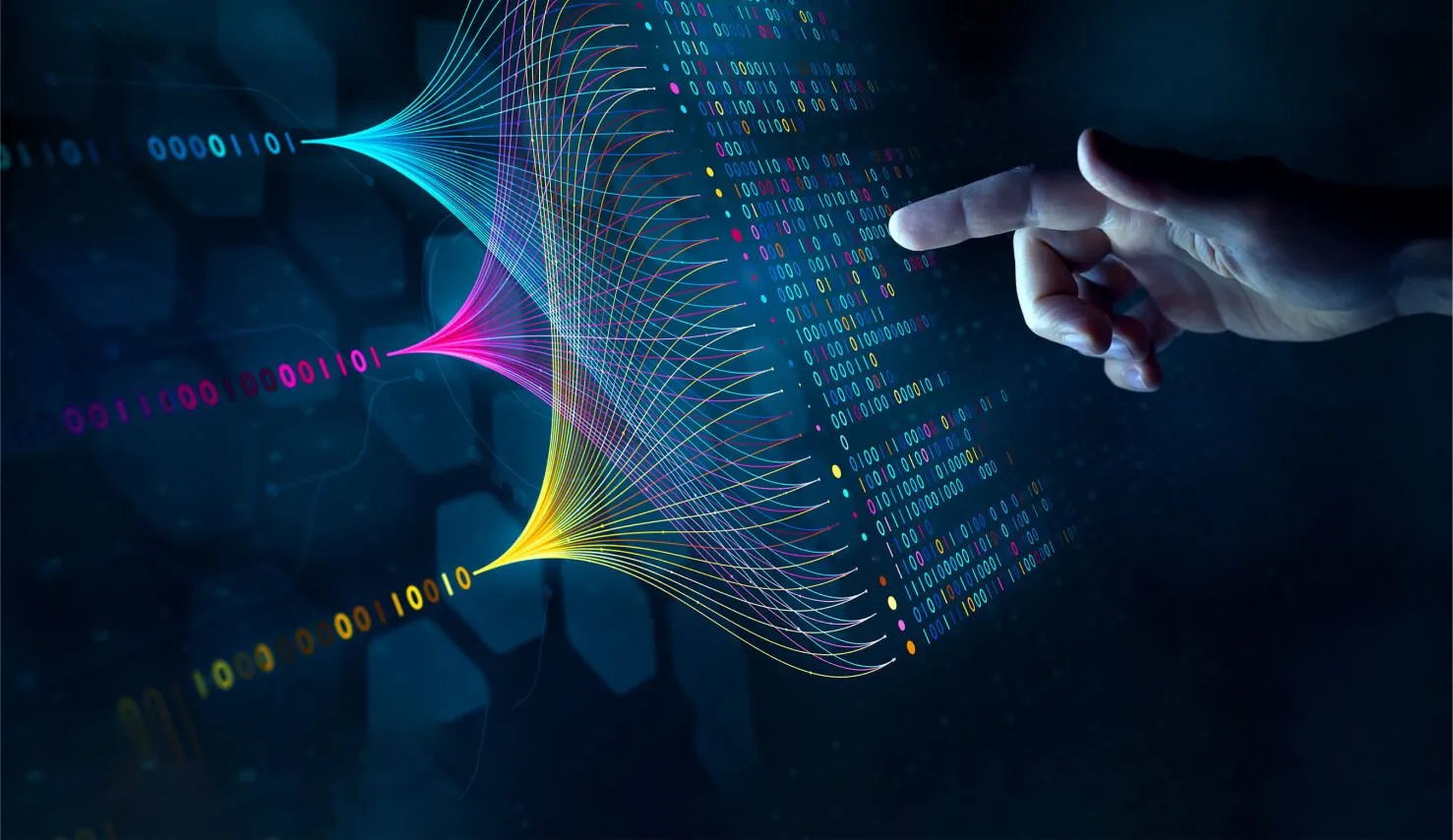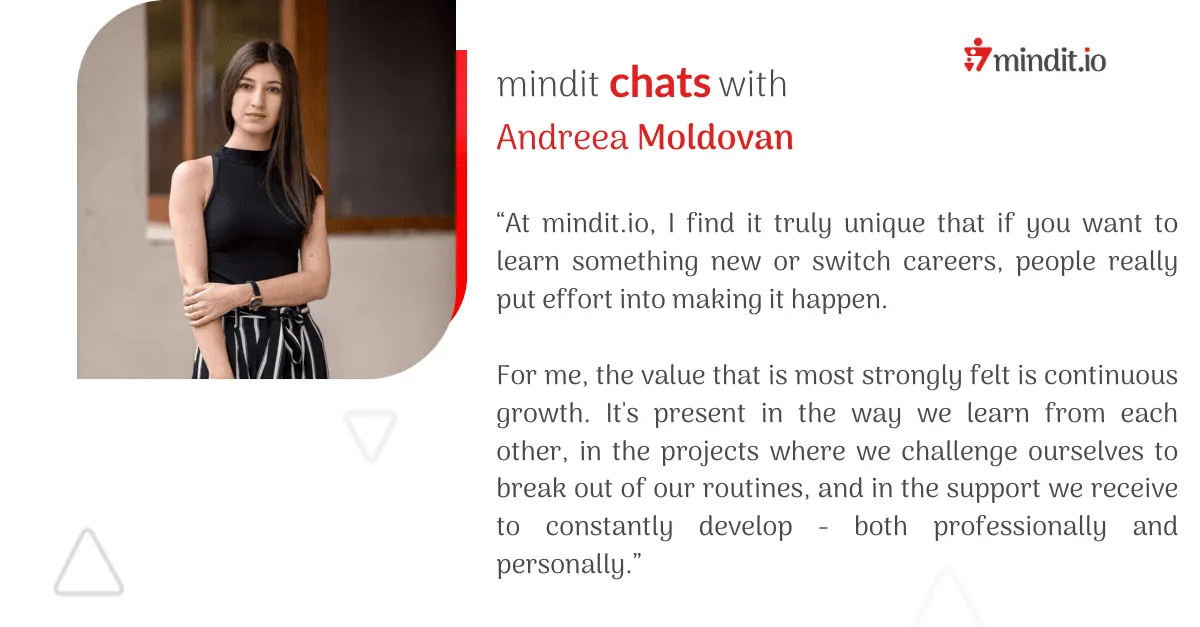The digital realm’s intricacy is not without its hurdles. One of the most pressing issues for 21st-century employees is the quest for accurate information. However, the fusion of AI technologies like LLMs (Large Language Models) and RAG (Retrieval-Augmented Generation) architectures can provide a brilliant, cost-effective, and user-friendly solution. This solution not only grasps and tackles the intricate situation but also delivers significant advantages to businesses and employees, revolutionizing how we work.
mindit.io has developed a unique solution, aptly named “Chat with your data,” distinguished by its clarity and human-centered approach. With its proven effectiveness, this innovative tool tackles a common yet often overlooked issue that impacts businesses of all sizes. Its user-friendly interface empowers users and fosters a sense of comfort and ease, making the transition to this new technology a smooth and pleasant experience. This reassurance and confidence in the transition process is crucial to our solution, ensuring the audience feels secure and supported in adopting this new technology.
The problem
Digital transformation’s benefits are unquestionable in monetary terms (P&L) and user engagement and satisfaction (for clients and employees). However, new challenges are also linked to the continuously increasing complexity of digital ecosystems.
Employees face a significant hurdle daily—the need to locate information. This seemingly straightforward task often becomes time-consuming and exasperating, resulting in a substantial dip in productivity. However, with the help of the Retrieval-Augmented Generation (RAG) solution, this process can be streamlined, enabling employees to concentrate on more strategic tasks and bolstering overall productivity. This productivity boost not only serves as a source of motivation but also sparks excitement for the potential of AI technologies to revolutionize the way we work. The future of work is not just about efficiency but also about inspiration and excitement.
The challenges of information retrieval in the digital workplace are multi-faceted:
- The first challenge is the sheer volume of information and the question of where to look for it: it’s like navigating a maze. The first level is the system: Should I look in OneDrive? In SharePoint? Or perhaps in that old filesystem that should have been discontinued last year? Maybe I should work with the raw data from the relational database… However, I remember that there is a PDF (that I don’t know how to find) with that information already structured and sanctioned by the high-level management. These challenges of information retrieval in the digital workplace are precisely what AI solutions like RAG aim to address.
- The second challenge appears when the same information might be of varying quality in different sources. It is already difficult to know where to find specific details, so when you have it in dispersed locations, how do you know that you have found the latest updated and approved version? What is the impact of using outdated data or information?
- Provided you know where to look, there is a third inevitable challenge: the information extraction process. Employees must browse projects, folders, screens, and database tables in a wasteful, time-consuming effort to retrieve the appropriate insights.
This problem has three sharp edges:
- The injured productivity: as we will see, the quest for the needed information is a time-consuming, recurrent task of low value.
- The frustrated employee: Employees are increasingly reluctant to accept exasperating work conditions. They prefer to change companies rather than struggle with unpleasant recurrent situations. So, preventing this frustration will improve productivity, positively impact employee satisfaction, and reduce turnover.
- Finally, there is one hidden issue that is often overlooked. The company’s self-knowledge. Do you know what your employees look for? Do you know what they find? Do you see what they fail to find? Do you know how valuable the information found is to them? Do they use the last sanctioned and approved presentation or corporate message? It is safe to assume that even if there is some knowledge about it, it is partial, to say the least, in a very euphemistic way.
The context
The digital era hit the world at the end of the 20th century. Businesses, Governments, and other entities began to automate and digitize their processes in search of improved efficiency, human error reduction, and increased velocity. Technology flooded all levels and areas of businesses with new concepts: CRM, ERP, HRM, BI, DWH…
But everything has upsides and downsides. This vertical approach was perfect for the efficiency of each process or department as a separate piece of the business. The challenge now derived from this fragmentation in silos: every department had its own ‘truth’ about what was happening. Often, those different realities were hard to reconcile. They could even eventually create relevant conflicts between company departments.
The 21st century began with a promising technology that would help companies not only store zounds of data but also break the silos to have a unified truth and understanding of the company finally. BIG DATA: putting data together in standardized and normalized formats. This breakthrough made it possible to compare sources and visions to create a unified and holistic sense of the business’ truth.
Soon, the scenario became more complex and promising: big cloud providers, such as Amazon Web Services, Microsoft Azure, IBM Cloud Platform, and Google Cloud Platform, entered the market. Cloud computing and document storage had joined other traditional storage alternatives, such as Microsoft SharePoint, Filesystems, and similar options.
By then, the problem above had become evident. After the initial improvement provided by the digital transformation process inherent to this century, employees saw how this progressive complexity created new issues—awfully frustrating issues without a trivial or easy solution—finding the correct information. Fast.
While vertically, information flows improved, horizontally… They became increasingly challenging.
An increasing problem of the 21st century
In 2001, the market intelligence firm IDC studied, researched, and analyzed this problem1. According to their findings, knowledge workers spent an average of 2.5 hours per day searching for information. This implies that they spend almost 30% of their time on relatively unproductive tasks—one could call that unnecessary document and data archeology. The 21st century had just begun on a growing digital transformation and digitation path.
First, there has been much debate regarding the “trustworthiness” of those figures and their interpretation. In fact, between 2001 and 2011, information became more transparent about the real-time spent looking for information, which was closer to 1 hour than 2.5 hours. 2 In any case, intuitively, one could have predicted an improvement in those costly efforts in an increasingly digitized universe.
Even so, 13% of working time is spent looking for existing information nowadays, which seems much compared to the time needed to find public information in Google or with LLM models.
In 2012, a report by McKinsey Global Institute revisited this subject to uncover that knowledge workers would spend 1.8 hours per day searching for and gathering information.3 The economic impact of this inefficiency can be further quantified to around $8.5 million each year in a company with 500 employees with an average salary of $75.000.
More recent surveys show a surprising increase in the number of hours employees use to find information. In 2022, a study conducted by The Harris Poll for Glean concluded that the time dedicated to such a task in the USA amounted to 2 hours a day.4 25% of their workweek. Some of the figures of this study are overwhelming: “26% of workers aged 35-44 spend a whopping 5 hours a day searching for information that they need.”
Another survey performed in 2023 by Coveo stated that most US and UK employees had to look for information in up to 6 different sources, averaging up to 3 hours per day. However, they also say they are more efficient than the previous year.5
Many conclusions may be extracted from these reports:
- There is a feeling of improvement.
- But figures show the contradictory impact of the vertical efficiency increase versus the horizontal efficiency loss.
The main conclusion is that this is a highly relevant issue impacting the efficiency and effectiveness of our company’s teams, and this productivity black hole has a tangible impact on any company’s Profit and Loss balance.
The solution
Let’s imagine.
Imagine a colleague who knows where all the data, information, and documents are.
Imagine he is always available 24×7 to help you (or your employees).
Imagine you can ask him to find anything you need; if it exists, he will let you know what it says and where to find it.
Imagine he finds all the available document versions and where they can be located.
Imagine that all this is done through a natural human-like conversation.
Imagine that it takes only 5-10 minutes.
The solution consists of a chat interface that leverages natural language processing to create a natural, human-like experience that is intuitive but efficient and effective in its pure state.
This assistant can be connected to any company system, including file repositories, object storage, databases, or corporate applications, from Microsoft Dynamics to SAP. It can index both structured and unstructured data. Even advanced formats such as images and audio can be indexed, provided they have the correct metadata.
The magic relies on the combination of an embedding and a vectorial database. An embedding is a process that converts the company data into a computer-friendly language that boosts the capacity to find information relevant to a given conversation input. The vectorial database stores that information and enables the system to find the most appropriate answers to the input queries. Finally, the Large Language Model puts the generative ingredient into our potion by giving a human-like answer to the employee’s request.
The user may request a list of documents or just a summary of the most recent data. The system will be smart enough to select the most relevant results and provide a well-structured answer in natural language or any format supported by Generative IA. In addition, the LLM technology is also exploited as a judge to measure the quality, relevance, and appropriateness of every retrieved possible answer, further elevating the quality of the final answer.
This basic behavior answers a corporate headache that has plagued corporations for over twenty years: the burden of dispersing information in corporate digital ecosystems.
Providing employees with a single application that connects them fast and naturally to the whole relevant knowledge corpus of the company is a safe bet for a successful digital transformation of your company, which will increase overall productivity and foster employee satisfaction while reducing talent turnover and at the same time, giving your company’s leadership insights about how well the information is flowing in the company, which is something that most likely they have no idea about at this time.
Retail and Transversal Use-case scenarios
The problem of information retrieval is very transversal. Even if we have referred so far to employees, it may also create better user journeys for our customers by enabling faster access to the information your company wants to make public. This implies that the number of use cases of RAG-based solutions is practically infinite. Almost every use case can be adapted to any sector. We have selected three transversal use cases to illustrate the possibilities of this technology. We have focused them on the retail industry to make them more earthly, specific, and detailed. However, they can be easily transported to any sector and business context.
Being closer to the front line
The distribution structure of the retail sector is complex. The workforce facing the final customers is usually far (physically and communicatively) from the central services. They typically get training in the company’s primary standards. But they actually learn them when they get hands-on. The most common issues are usually the easiest to learn. Once solved, the knowledge rests, and repetition solidifies it. Infrequent problems are much more daring. But struggle comes when there are changes: rules change, promotion changes, policies change… Even products change. How do you keep your front-line workers updated with the latest changes? How can you provide them with a trustworthy channel available 24/7 worldwide? Enable an app for your front-line employees so they have a trusted advisor that can answer any question regarding any crucial item of the company: the policies, information regarding the products, or any information or data that the marketing (or any other) area thinks that the front-line employees must be able to answer.
There are three significant applications to this use case:
Onboarding virtual guide: even if the store model is by third-party franchises, stores co-owned with business partners or wholly owned stores, the goal is to ensure that all the public-facing employees share the same standards. They must learn all the procedures and processes as soon as possible and how the company expects them to proceed in any given scenario. It is possible to specialize the virtual assistant to focus on answering any question or issue new joiners might have. Advanced versions of this use case may include interactive training that might be made attractive with gamification techniques, for instance, asking questions every other day about products, services, and other important onboarding information and keeping a high scores list with some ‘gift’ for the season winner. It can also have step-by-step tutorials or guides about the most complex processes that might be useful.
Continuous training: if your company does not struggle with the challenges of frequent new joiners in the client-facing workforce, then the challenge may be to keep that workforce up to date with the latest changes, updates, and most sensible rules, regulations, and policies. Such a channel may allow the workforce to access the latest versions of the document. This use case is highly similar to the Onboarding Virtual Guide, with slight nuances about the stress of communication and the format of shared information. It could also benefit from step-by-step assistance and gamification.
Global Support: the most ambitious view is not any of the previous two nuanced approaches but to consider both on top of the most forthcoming use case: the capability of consulting any relevant document, procedure, regulation, or applicable law (for instance) to ensure the best experience to the customers visiting the store. Ambition can combine this use case with the third use case defined in this section (A Catalog Know-it-all). However, this virtual assistant to the store workforce can be enhanced with access to continuous training, and it can also become the expert guide for new joiners to your cause.
This implies that your central marketing and operation teams (among others) can be closer to the front line of your corporate structure, providing them with a high-value assistance tool that requires no high-tech knowledge (other than talk and write) and can be ubiquitous thanks to mobile phones, tablets and even Points of Sales.
In summary, new and old employees can use the chat interface to access training materials, company policies, and procedural documents, ask questions, and receive guidance from the AI, obtaining a drastically shorter learning curve and smoother employee adaptation.
Finally, by analyzing the interactions of your front line worldwide, your company will have a much clearer vision of what is happening everywhere. Who struggles the most with what and why, so appropriate corrective action may be taken. More powerful store experiences are mandatory to increase sales through a better customer experience.
Faster Marketing, Better Marketing
Developing Marketing Campaigns is complex. Define a target group. Define the value of the product to sell. Find the message. Check that the message aligns with the company’s values—research past campaigns, which did well and which did not. Try to hypothesize why and find evidence to confirm or refute the hypothesis. Iterate. Do field tests. Adjust. Iterate until somebody green-lights the campaign.
Indeed, every company has its marketing processes and culture—some more complex, some simpler. However, the capability to interact fast and simply with a company’s data history may have a notable impact on all companies.
Complex companies can do things faster. With RAG-based solutions, research times become minimal, and creativity is boosted. Your virtual assistant can propose a draft campaign with the target group, the proposed message aligned with the values, considering the most successful past campaigns, and avoiding past pitfalls.
More straightforward companies will fuel their marketing teams, which will be able to create more powerful campaigns with minimal additional cost. Better marketing. Inexpensive.
Let’s review two ways RAG-based solutions will deliver on those promises of velocity and quality.
Campaign drafting: facing a blank page is particularly discomforting, especially if dazed by fuzzy, conflicting ideas that are not brightly aligned with the corporate image and tradition. There is much to do and many expectations from the stakeholders involved.
So, even if it feels utopic to a certain extent, with RAG-based technology, an AI can help you create a first draft of the campaign in minutes. And that is the beauty of it all.
- First, the system must be fed with the Mission, Vision, and Values, the main strategy lines (at least those made public), and other relevant data regarding the company’s marketing strategy and positioning in the market. That ground truth allows the system to understand the company and propose drafts aligned with it.
- Next, the system must be fed with the history of all relevant and available marketing campaigns. This history should be accompanied by some metrics or insights related to the success or lack thereof. This will set up the system to infer patterns and ideas that usually work well for a definite target and which ones do not.
- The last part depends on the users’ ability to get the most from the system. It is essential to make the best request possible. Preparing a clear and appropriate prompt is vital. Hence, the system knows what we expect, including the main ideas to elaborate, the templates to produce, the sections to create (targets, tone, main messages), and tests. Many tests a human would need days and weeks to develop could be created in minutes.
- Finally, the user needs to review the answer produced by the AI, fine-tune it, and check which ones are valid or exciting and which ones are not. Once this is done, it is possible to keep working from the human perspective or continue iterating with the system by asking it to improve the draft according to the instructions only an expert human could think of.
Campaign evaluation: AI can generate content based on previous content quickly. However, it also can see patterns and relationships that are not evident to the human eye. So, leveraging the same data ingested in the system for the Campaign drafting, once the campaign has been designed, filtered, and adjusted by the human marketing team, the AI can give a score to each dimension of the campaign, which measures the success probability founded on the success and failure of previous campaigns, highlighting the strengths and weaknesses of the campaign. This assistant will rate your campaign ideas according to past successful and failed campaigns. However, humans must make the final decision on each dimension. Nevertheless, the benefit of such insights covers getting clues on how to improve the campaigns and having stronger arguments to defend the campaign in front of the stakeholders and decision-makers of the company. This evaluation may be beneficial when comparing two or more prospective campaigns.
Both approaches, Campaign drafting, and Campaign evaluation, are fully compatible. The entire process could have these steps (from a fundamental creative perspective):
- Campaign Drafting.
- Human revision and improvement
- Campaign Evaluation.
- High-level final decision.
However, apart from the advantages mentioned for all kinds of companies, additional features are derived from using this solution in this scenario. One is the possibility of interacting with the campaigns. Once the campaign is defined and fed into the system, you can probe it with questions regarding its impact on various customer segments and its consistency with the company history.
Know-it-all Customer Assistant
If you are looking for an impressive and disruptive customer experience when your company has a very extensive and/or complex product catalog… It can be a huge challenge. Traditional Conversational AI solutions are not scalable. They require a significant amount of training and set-up for them to start becoming efficient. The bigger the extent of the catalog, the bigger the cost, effort, and time-to-market required. In such a context, the cost-benefit equation may not be worthwhile. However, with a RAG-based solution, it is possible to provide a fast and comparatively cheap solution compared to a digital assistant, enabling a conversation with your product catalog. So now the situation is overturned. You can open a communication channel between your clients and your catalog of products. 24×7. Through an app, a web, or both. Even if it’s furniture, groceries, miscellaneous products, or any product line, no matter how diverse it is, such an application is a game changer.
This conversation goes further than just keyword searching for the product fiche or card, which is something not disruptive, but being able to ask which of the products are most appropriate for solving a problem, which products will fit better your house space, environment and context, and other conversations that we never used to have with virtual entities. This solution can become your clients’ partner in renewing the decoration of a room, finding the clothes to suit a new style or to complement your current styles, or even become a problem solver for your clients: let them tell your system their problems and let the RAG-based solution combined with LLM to find which products could solve the problem in an unprecedented, innovative way.
Your clients may not know what they need, but they can state their problem to the app and receive ideas based on your products.
This can go even further by letting the client know additional information such as the price, availability, and the closest store to the user’s location to get it, provided they don’t prefer to buy it online and receive it at home. Like this, you get a virtual assistant combining legacy features (check products, characteristics, and availability) with advanced conversations regarding innovative approaches to the use of products, linking problems to the products that may become unthought solutions, and other advanced AI features.
Conclusion
Imagine a cost-effective and fast solution.
Now you can stop imagining. Just contact mindit.io
And start a conversation with your company’s data.







































